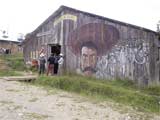Church helps organize indigenous people

Zapatista supporters discuss matters mentioned in the Good Government Meeting outside the Ovantic meeting hall. More than 300 Zapatista supporters were present for the meeting where they discussed pending matters. The meeting hall fascade has a representation of Emiliano Zapata, the revolutionary figure which they name themselves after.
Mexico’s president during the period between 1970-1976 was influenced by two elements: the ideological and political promotion of leftist forces at the international level and the national sympathy for the populist campesino movement in Mexico that grew as a result of the trifling repression used against the student movement during 1968.
In an attempt to channel the sympathy for the campesino movement into institutional groups, President Luis Echeverria created the Indigenous Congress of 1974. Chiapas was chosen to be its seed largely due to the state’s status as the least developed state.
The governor of Chiapas was given the task to organize the Congress, even though he had no relationship with the indigenous people.
Thus, the governor solicited the help of Bishop Samuel Ruiz to bring about the Indigenous Congress.
The choice of Bishop Samuel Ruiz as an auxiliary to the Governor was not without reason.
By that time the Bishop was in charge of a diocese of 612,000 church-goers, which represented 50 percent of the state’s population, of which 40 percent were indigenous.
The priests and nuns, however, did not consider themselves politically formed. They feared they would be used by the government.
Thus, they were compelled to find guidance and support in The People’s Union, a leftist organization formed in 1969 and early 1970 as an answer to the repression of the student movement of 1968.
The bishop conditioned his participation in the Indigenous Congress on whether it would be an authentic forum of expression and complaints of the unjust conditions the indigenous under. The government accepted.
The Congress was organized during a year around four fundamental themes: land, health, education and commerce.
On the area of land, the indigenous farmers believed the land should belong to those who worked it, and not to the land owners who oftentimes acquired the land from indigenous people years before through corrupt or suspicious means.
The demands made on behalf of the indigenous people with regard to health and education, were less controversial.
They wanted equal access to education and health, including vaccination of the children and medical attention of the more common sicknesses.
Commercially the representatives of the indigenous people requested: the prevention of the exploitation of the indigenous people by means of the commercialization of the products of their labor (corn, bean, coffee beans, terrestrial birds and cattle).
They thought commercialization of these products should be regulated.
Although the Indigenous Congress of 1974 did not meet the Indigenous people’s expectations on their demands, it did have some positive results.
It gave rise to a certain conscience of the problematic common denominator to the different indigenous communities in Chiapas.
Conversely, opposed to the goals of the president, the Congress produced an awareness within the indigenous communities of their tribulations and the lack of aid they would receive from the government in solving their problems.
In a way, the Congress encouraged the Indigenous to look outside the government for a viable solution.
It also allowed leaders and groups to stand out within the indigenous communities and promote a more organized work.
The creation of the Union of the Ejidos Quiptic la lecubtesel, meaning “our liberation force,” in 1975 was one of the consequences of the Indigenous Congress.
The new organization grouped the majority of the Tzoltzal communities of the Canadas and another Union of Ejidos that united the Tojobal communities of the region.
In 1980, the Union of Ejidales Groups of Solidarity Farmers of Chiapas was born.
Its purpose was to congregate all the independent organizations into one federation.
This organization would later build the social base of the Zapatista Army of National Liberation, or the EZLN.
Your donation will support the student journalists of Missouri Southern State University. Your contribution will allow us to purchase equipment and cover our annual website hosting costs.



























